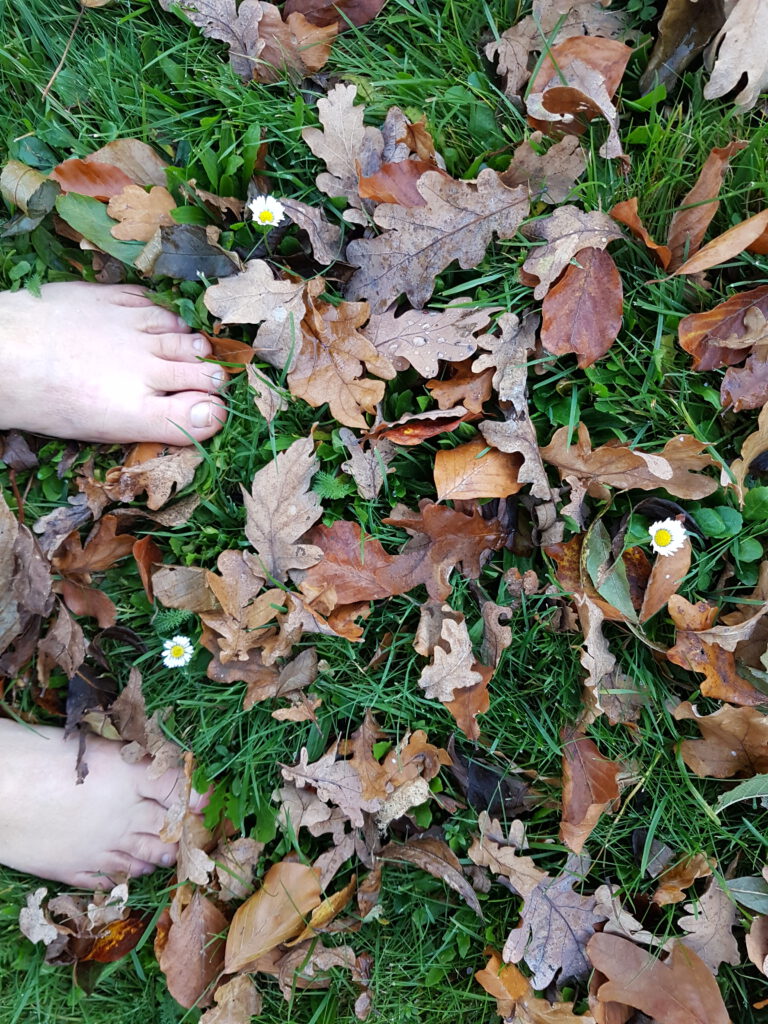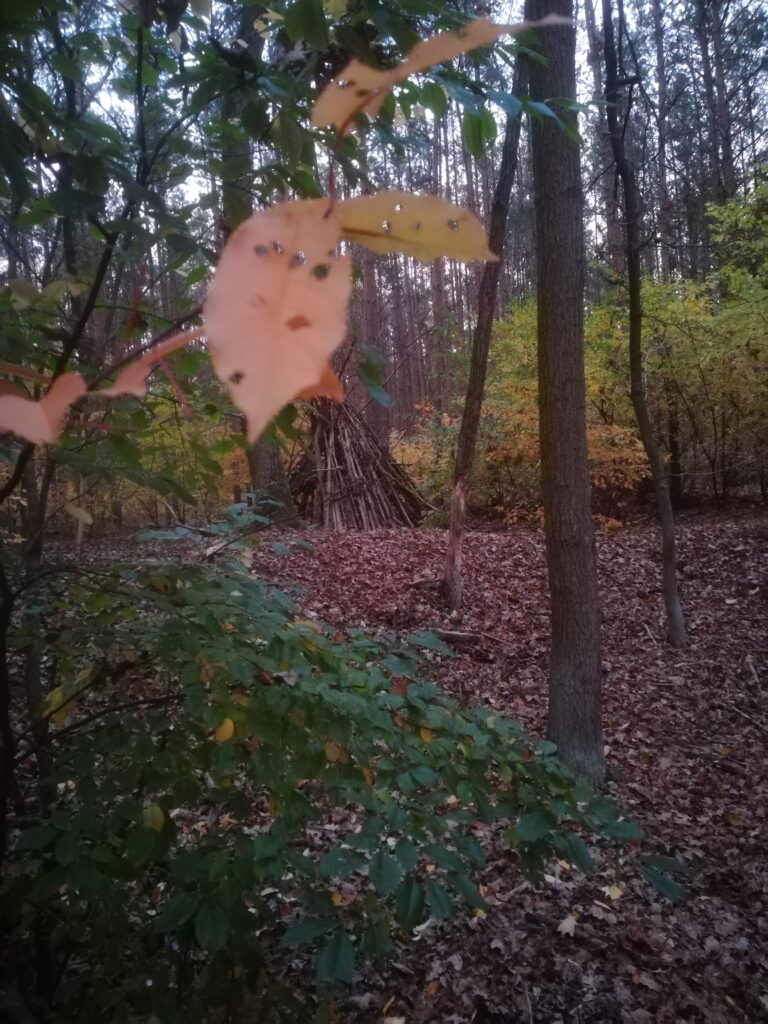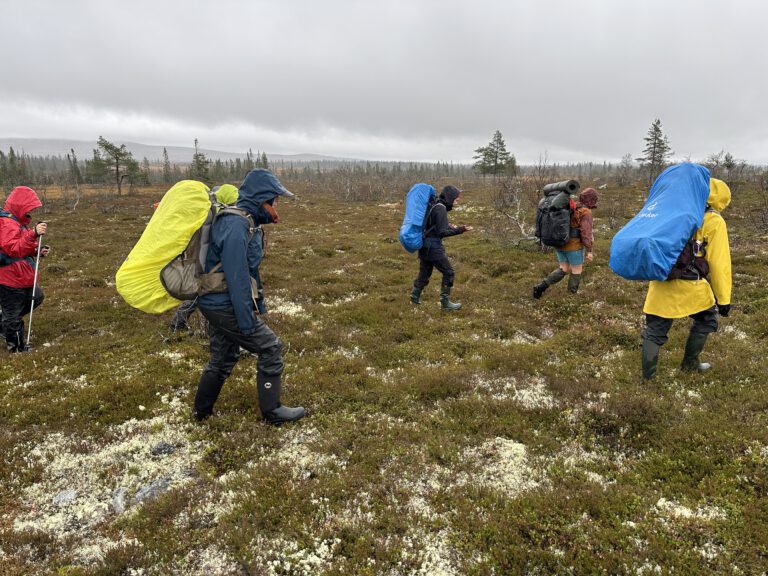EWM course outcome

For outsiders our course lessons often look just like some chill people hanging out around a fire. That may sometimes be true, but there is always something more happening actually.
The teachings and learning experiences are more subtle and not as obvious as, say drawings and paintings in an art course or thick folders of homework in college courses.
Throughout the course there is a shift happening from “going out into nature” to “being part of nature”. From the outside this may look exactly the same – a person taking their backpack and going for a walk in a forest, park, field, wherever outside. But the person themselves is doing something quite different and the inside of the backpack looks probably different, too.
Let me explain in some detail:
The person “going out into nature” feels separated from the “nature” out there. They have to prepare and brace themselves to survive challenges and dangers from a potentially hostile nature. They tend to take a lot of gear with them. Outside they look at their environment like one looks at a movie or a painting, as a scenery to their own life, without deeper understanding. They use this scenery as they see it (often leaving long-lasting traces) and afterwards come back to the safety of their man-made home.

The person “being part of nature” knows its place in the universal web of life and feels connected to strands of this web near and far. They go out to feel at home in nature. Their backpack may contain some water and food, too. But usually there is less shiny gear, less protection from unlikely dangers, less overall stuff. They tend to wear less clothes or shoes and immerse themselves more in all elements. They leave less traces, they connect deeply to the places they visit, they treat other living beings with as much respect as they want to receive themselves. They are grateful for nature´s gifts and bid farewell to the place before they return to the isolation of their man-made home.
The returning person actually can look different even from the outside, some dirt may prove immersion and contact.
For many of us the EWM course was a re-awakening of our inner child. As children, most of us were playing outside, rolling in the mud, throwing leaves, knowing the hidden places in the nearby hedges, building forts from sticks and moss. Growing up there was less and less space in our life for this simple connection to our environment. Now we had to reconnect and to find this sense again to being part of something bigger. Starting out with the first course days and some other individual tasks to be done outside (like sit spot) we gradually built our web of nature connection, culminating during the 3 weeks tour to Sweden. Most of us (me included) have never spent such a long time exclusively outside before. We returned to Germany, to our families, to college and work changed not only from the outside (leaner, suntanned, stronger) but also and maybe more pronounced changed at heart. We know each other and ourselves on a deeper level. We know more about our abilities and skills, how to communicate, how to rely on the group. We feel more at home outside.
Of course, not everyone is experiencing this shift to the same extent or in the same way. Some are just a bit more comfortable outside and more self-confident in other settings. Some are re-discovering old habits or hobbies outside. Others take their time outdoors to new levels in different ways.
Some profound insights from this course can be found in every participant.
We are already using these mentoring tools and skills not only in our everyday work, we are utilizing them in the planning process for our practical exams, comparing different methods, finding the most natural way to implement them (see also earlier blog posts, for instance “bees and trees…” from September 2021).
The time sitting around a fire is always spent sharing these experiences, learning from and with each other, connecting as a group, caring for each other, making plans, striving to heighten our awareness and understanding, sharpening skills, and so much more…

Don´t be fooled by cursory glances and superficial appearances!
The chill people around this fire are working hard, but that doesn´t keep them from enjoying the process. Christine Tirkot
Celebrating gratitude – the last day of EWM2020
On Wednesday March 9th we last year students met for the last time as a course in the usual setting. Everybody was helping. Preparing a comfortable meeting place has become second nature to all of us. Some were bringing food or cooking over the fire. We spent the day focused on gratitude. Everyone was contributing – sharing food, guiding group rituals and singing, sharing stories and memories of learning content. Some were putting finishing touches to their crafting projects. We appreciated and celebrated nature ´s spring awakening. And we acknowledged the sad topic of war in Ukraine with peace songs.
Great emphasis throughout the day was on gratitude for everything that is special about this course and the content we have been studying, the insights we take with us. This course is not about dry teachings soon to be forgotten, but about learning from and with each other, about the lasting connection and the re-connecting to nature we are experiencing and spreading.

Especially the 3 weeks tour to Sweden helped us to immerse ourselves in nature and to gain insights, knowledge and skills to pass on to the next generation. This is our task as educators. Many of us are already carrying the spirit of the course into their work in childcare institutions. How could future generations learn to protect their environment without learning to love its beauty?
Our mentors with their innate enthusiasm instilled in us the desire as well as the skills and knowledge to lead children and adolescents onto their individual paths to exploring nature, to find their own thrill and joy of discovery. Now we are the multipliers teaching and mentoring children to know, to love and to protect their environment.
I feel deeply grateful for being a participant in this course!
Without this experience for instance the forest group project in the SOS children´s village would not exist. Weekly children from age 6 to 12 visit the nearby forest and explore the natural environment in a playful way. Especially children and youths living in residential homes benefit from this method of learning and connecting to nature, in experiencing self-efficacy and developing resilience. One of our ongoing projects is the exhibition of trash in front of the SOS village drawing attention of the public to our waste picking activities in the forest.
Simone Geguszies






